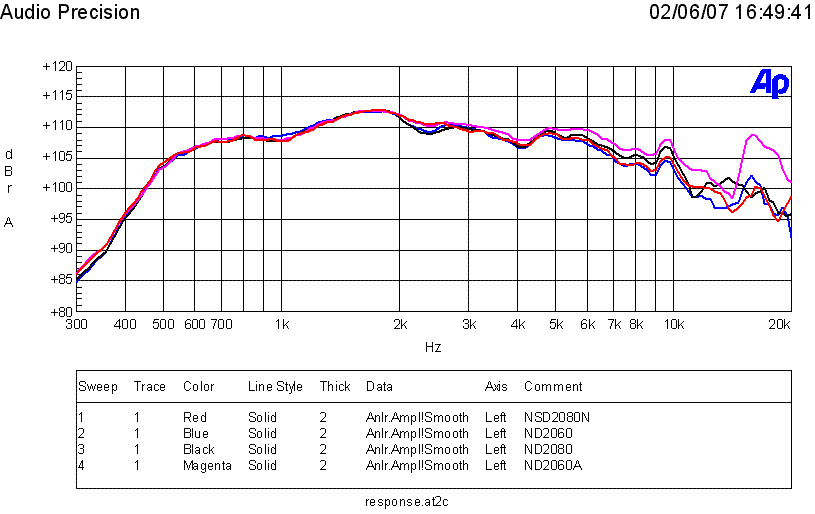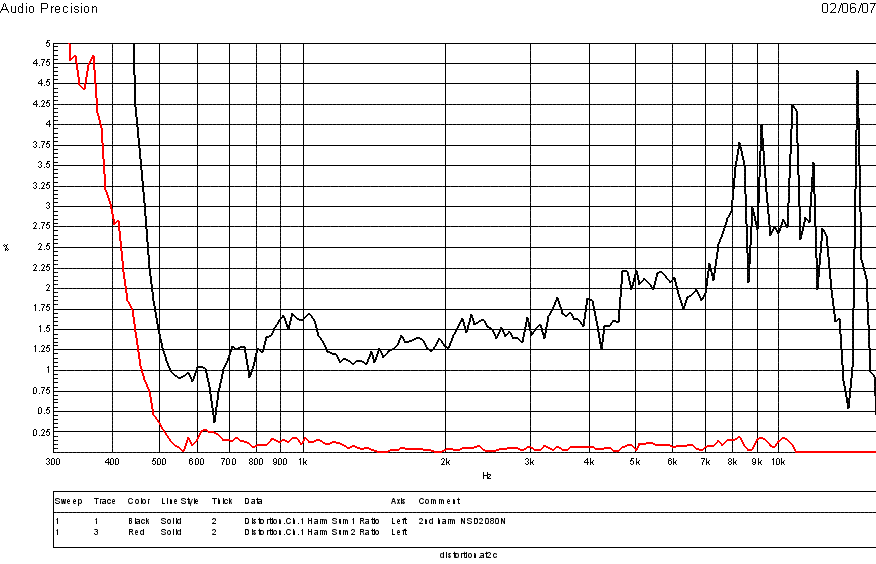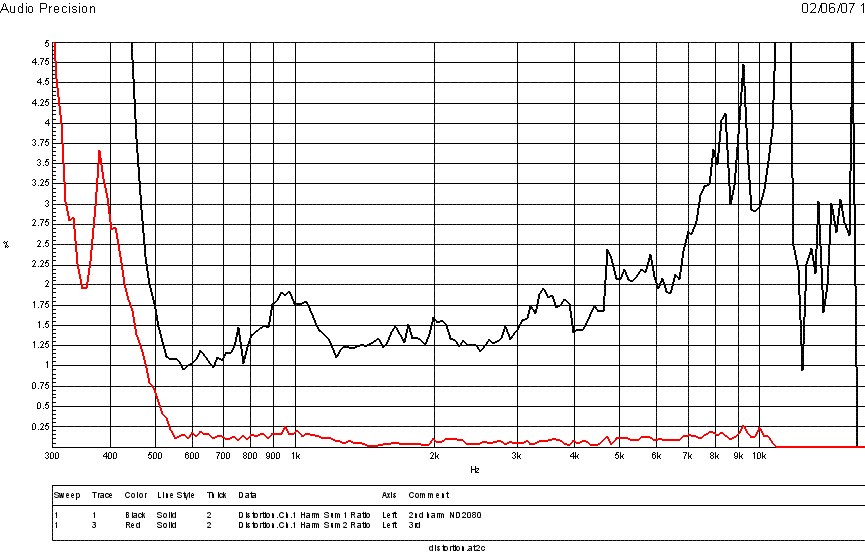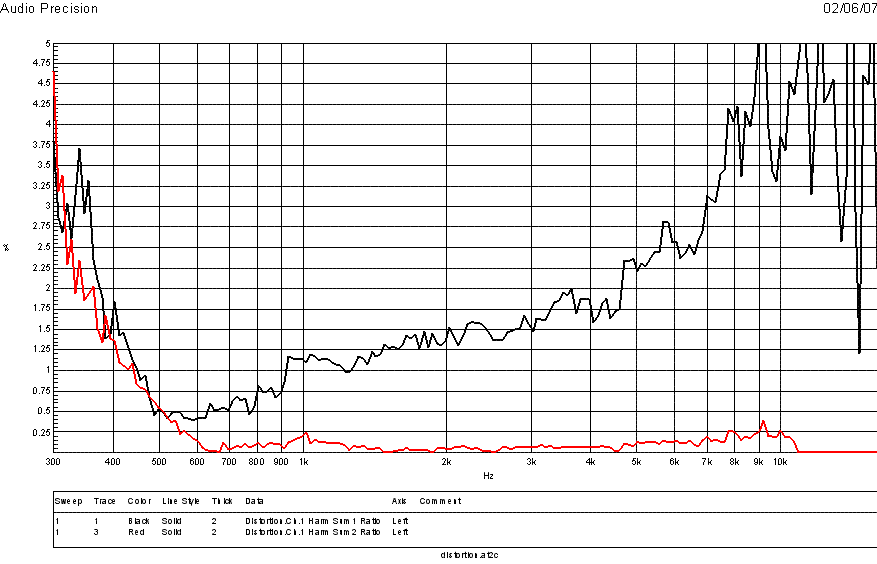FWIW; here's what ARTA (STEPS ) indicates as the distortion content for this horn/combo ( at the low levels I listen to ) . ( This wasn't high-passed ) .

cheers >< 🙂
cheers >< 🙂
Last edited:
Great stuff guys -thanks! 
Lots of good info so far. As Catapult says, we haven't seen anything worse than a cone driver so far. Maybe distortion rises faster?
EarlK - the group delay you show seems to be within the standard "2 cycles, thus inaudible" window. But you woofer coming in seems to dampen even that.
Jean-Michel has an interesting approach in that he does not like a delay of more than 10 cm and any frequency. How accurate is our auditory depth perception? Left to right can be very precise - depth I don't know. And it must change relative to distance. (Think about it)
So far we are not seeing phase problems any worse than with cone drivers. Maybe distortion is worse. Is it?

Lots of good info so far. As Catapult says, we haven't seen anything worse than a cone driver so far. Maybe distortion rises faster?
EarlK - the group delay you show seems to be within the standard "2 cycles, thus inaudible" window. But you woofer coming in seems to dampen even that.
Jean-Michel has an interesting approach in that he does not like a delay of more than 10 cm and any frequency. How accurate is our auditory depth perception? Left to right can be very precise - depth I don't know. And it must change relative to distance. (Think about it)
So far we are not seeing phase problems any worse than with cone drivers. Maybe distortion is worse. Is it?
Hello EarlK,
Phase curve presentation is a hard task (that's why it is preferable to use group delay curve). The unwrapped phase curve you show still contains some linear phase content due to some uncorrected propagation delay.
Could you please give the .pir file of the pulse measurement that lead to that phase curve.
Best regards from Paris, France
Jean-Michel Le Cléac'h
Phase curve presentation is a hard task (that's why it is preferable to use group delay curve). The unwrapped phase curve you show still contains some linear phase content due to some uncorrected propagation delay.
Could you please give the .pir file of the pulse measurement that lead to that phase curve.
Best regards from Paris, France
Jean-Michel Le Cléac'h
Here's the phase response of the Altec driver on the Emilar radial horn ( hopefully this is the info that you're after ).
Jmmlc said:Could you please give the .pir file of the pulse measurement that lead to that phase curve.
I'll post that file ( after retesting ) once my "key" is delivered from ARTA ( ie; I've just purchased the licence for this software ) .
>< cheers 🙂
ps ; J-M, What do you hope to illustrate once you strip out the propagation delay from the phase curve ?
Member
Joined 2003
18 Sound info
Here are FR and distortion plots for the 18 Sound 2" exit drivers. (14xx series drivers with a factory 1.4"-2" conical adapter).
Measured 1 meter/1watt from the mouth of an XR2064 horn in an anechoic chamber...or about 110db. The XR2064 is rated CD to 1.2k.





Here are FR and distortion plots for the 18 Sound 2" exit drivers. (14xx series drivers with a factory 1.4"-2" conical adapter).
Measured 1 meter/1watt from the mouth of an XR2064 horn in an anechoic chamber...or about 110db. The XR2064 is rated CD to 1.2k.





Hello Earl K,
Once you correctly correct the unwrapped phase curve from the effect of the mean group delay inside the useful bandwith of the loudspeaker you can see a lot more things...
Eventually to visualize the effect you can see the phase curve in Hornresp and use the delay tool (in the "tools" menu).
Best regards from Paris, France.
Jean-Michel Le Cleac'h
Once you correctly correct the unwrapped phase curve from the effect of the mean group delay inside the useful bandwith of the loudspeaker you can see a lot more things...
Eventually to visualize the effect you can see the phase curve in Hornresp and use the delay tool (in the "tools" menu).
Best regards from Paris, France.
Jean-Michel Le Cleac'h
I'll post that file ( after retesting ) once my "key" is delivered from ARTA ( ie; I've just purchased the licence for this software ) .
>< cheers 🙂
ps ; J-M, What do you hope to illustrate once you strip out the propagation delay from the phase curve ?
Hello J.H.
My "key" came in for ARTA and therefore I've included 2 files ( zipped ) for you to play with .
- Here's what I just shot ( a screen-shot from one of the ARTA files ) ;

- Here's what Holm-impulse displays as a phase curve ( using the same pic position as the ARTA testing ) ;

- I'll be interested to see if you can make the phase display from the ARTA files, look the same as HolmImpulse .
- FWIW, I don't see how any of my phase curves can be construed as anything approaching "linear phase" .
- Here's John Ks' example for review, since (IME ) this is a good look at what linear phase ought to look like .
>< cheers 🙂
My "key" came in for ARTA and therefore I've included 2 files ( zipped ) for you to play with .
- Here's what I just shot ( a screen-shot from one of the ARTA files ) ;
- Here's what Holm-impulse displays as a phase curve ( using the same pic position as the ARTA testing ) ;
- I'll be interested to see if you can make the phase display from the ARTA files, look the same as HolmImpulse .
- FWIW, I don't see how any of my phase curves can be construed as anything approaching "linear phase" .
- Here's John Ks' example for review, since (IME ) this is a good look at what linear phase ought to look like .
An externally hosted image should be here but it was not working when we last tested it.
>< cheers 🙂
Attachments
Hey Earl,
I notice that you like to tilt the top end way up. Is this because you listen off axis, or just a personal taste thing?
I notice that you like to tilt the top end way up. Is this because you listen off axis, or just a personal taste thing?
panomaniac said:Hey Earl,
I notice that you like to tilt the top end way up. Is this because you listen off axis, or just a personal taste thing?
- I listen a ways off axis from the 2 speakers' center line, plus the speakers are toed-in @ 20 degrees .
- My room is long & narrow ( with a good deal of LEDE treatment up front ) . Still , higher Q horns seem to work better for me ( after trying a few ) /with an ability to create a deeper sound stage ( in my place ) . They're not for everyone I know / but they work well for me.
- I think the Emilars are too wide in my place .
- I'll be going back to the H5038s ( JBL paragon ellipticals ) soon enough .
>< cheers 🙂
Last edited:
Do you have photos of the Emilar horns just for our reference?
Here's a few ( very ) grainy pics that reside over at LHF ( I know they're not primo audio-voyeur material / but that's on purpose 😉 ) .
- That's a JBL 2426/7H connected to the Emilar horn . ( The 2427H came with a built in 1" to 2" adapter-snout ) .
- Here's the combos' FR ( included for the sake of retaining some relevancy to the original post ) 🙄

>< cheers 🙂
Last edited:
Before this thread sinks into oblivion 😉
Hey Panomaniac,
- Perhaps you might find a way to get Jack Bouska interested in sharing his views on employing low(ish) crossover points on smaller horns ( with their higher F3 points ) .
- Here's his small OS inspired "waveguide" connected to a JBL 2441 .


- At one time he used 6 db slopes ( then tried 48 db ) throughout his 5-way MTM setup ( with either choice maintaining absolute polarity ). I think he crossed into this horn ( oops , waveguide ) at around 1K .
- I believe many users ( for this size of horn ) might choose a crossover point an octave higher ( based on historical "best practise" approaches ) .
Here's the FR of the pictured combo ;

>< cheers 🙂
Hey Panomaniac,
- Perhaps you might find a way to get Jack Bouska interested in sharing his views on employing low(ish) crossover points on smaller horns ( with their higher F3 points ) .
- Here's his small OS inspired "waveguide" connected to a JBL 2441 .
Jack Bouska said:from the Original LHF thread ;http://www.audioheritage.org/vbulletin/showthread.php?t=12126 My choice of tractrix mouth instead of 1/2 round radius was apparently a wise one, as borne out by these graphs. The sound is indeed very natural and clear. To quote my audiophile friend on his first listen: " I have never heard horns sound like real music before this!"
- At one time he used 6 db slopes ( then tried 48 db ) throughout his 5-way MTM setup ( with either choice maintaining absolute polarity ). I think he crossed into this horn ( oops , waveguide ) at around 1K .
- I believe many users ( for this size of horn ) might choose a crossover point an octave higher ( based on historical "best practise" approaches ) .
Here's the FR of the pictured combo ;
>< cheers 🙂
- Perhaps you might find a way to get Jack Bouska interested in sharing his views on employing low(ish) crossover points on smaller horns
Good idea. I'll shoot him an email. You might, too.
Thanks.
Hey Panomaniac,
- Here's his small OS inspired "waveguide" connected to a JBL 2441 .
🙂
Small waveguides are always difficult, but those are not really very good polars - I mean for the size they might be (I would never go this small) but compared to what a larger device would do they are not very attractive. They are acceptable over about 1.5 octaves, but then the necessary crossovers complicate things terribly.
Hi EarlK,
I finally broke down and bought an ARTA license too 🙂 so I decided to take a look at the file you posted for your unfiltered horn. I wanted to take a look at whether or not the low-end roll-off is minimum phase. By minimum phase, I mean the theoretical phase you would get if you did a Hilbert transform on the SPL. I think you referred to that as linear phase before but minimum phase is more correct.
Short answer, almost but not quite. Longer answer read on.
Here's what I did to get ARTA to make sense of the phase. The first pic is the impulse response. I clicked the invert button so the first pulse goes positive. If it goes negative the phase will look goofy. Then I right clicked on the first peak to set the marker. Clicking the Get button gave me an estimated delay of 3.135 ms.

After the pic was shot, I double-right-clicked to clear the marker. That left me with an ungated impulse. Then I plotted the freqency response and phase. There was a lot of hash below 200 and above 15K so I narrowed the frequencies being shown. Then, I clicked View / Excess phase. Excess phase is the difference between the real phase and the minimum phase. I clicked Edit / Delay and reduced the delay to 3.125 ms to flatten the excess phase as much as I could. With a perfect driver and a perfect measurement, you could get the excess phase to be a flat line at 0. The best I could get was a rise at the low end to 80 degrees at 200 Hz.

Finally, I unchecked Excess phase to take a look at the real phase. It's similar to the minimum-phase plot JohnK posted but, as I noted above, the bottom end isn't perfectly minimum phase.

I finally broke down and bought an ARTA license too 🙂 so I decided to take a look at the file you posted for your unfiltered horn. I wanted to take a look at whether or not the low-end roll-off is minimum phase. By minimum phase, I mean the theoretical phase you would get if you did a Hilbert transform on the SPL. I think you referred to that as linear phase before but minimum phase is more correct.
Short answer, almost but not quite. Longer answer read on.
Here's what I did to get ARTA to make sense of the phase. The first pic is the impulse response. I clicked the invert button so the first pulse goes positive. If it goes negative the phase will look goofy. Then I right clicked on the first peak to set the marker. Clicking the Get button gave me an estimated delay of 3.135 ms.
After the pic was shot, I double-right-clicked to clear the marker. That left me with an ungated impulse. Then I plotted the freqency response and phase. There was a lot of hash below 200 and above 15K so I narrowed the frequencies being shown. Then, I clicked View / Excess phase. Excess phase is the difference between the real phase and the minimum phase. I clicked Edit / Delay and reduced the delay to 3.125 ms to flatten the excess phase as much as I could. With a perfect driver and a perfect measurement, you could get the excess phase to be a flat line at 0. The best I could get was a rise at the low end to 80 degrees at 200 Hz.
Finally, I unchecked Excess phase to take a look at the real phase. It's similar to the minimum-phase plot JohnK posted but, as I noted above, the bottom end isn't perfectly minimum phase.
Attachments
Dennis, Thanks very much for that ! Nice Line .
- Now, was hitting that "Invert" button the logical & correct thing to do ? ( apart from achieiving the articulated / preferred straight line result ),
- The reason I ask is that I'm fairly comfortable working with mathematic reciprocals / so I'm a bit perplexed as to why I didn't see this flipping action as a logical extension of the post processing routine / ie; I could use anothers' thoughts on this ( my blind-spot ) .
>< cheers 🙂
I think it's just a convention that a 'perfect' impulse response goes positive, i.e. a positive voltage spike moves the diaphragm toward the listener and then back to zero. Generally you'd expect to see the tweeter's phase near 0 at high frequencies after you remove the delay. If the signal is inverted, it will be near -180.
The signal could be getting inverted anywhere in the playback or recording chain. And, depending on your crossover, you might want to invert the tweeter on purpose but that's a separate issue from measuring the individual drivers.
The signal could be getting inverted anywhere in the playback or recording chain. And, depending on your crossover, you might want to invert the tweeter on purpose but that's a separate issue from measuring the individual drivers.
Panomaniac said:- Looking for measurements that any of you may have of horns and waveguides near their low cut-off frequency.
- Standard practice is to high pass the horn at least an octave above its cut-off frequency.
- Is this really needed at home hi-fi levels? Some say no.
- So if you have phase, distortion and impulse measurements that you would like to share, please do.
- Ummm, Pano,,, are you going to post any measurements of your own stuff ?
- What are your thoughts to the questions that you've posed ?
>< cheers 🙂
Last edited:
- Status
- Not open for further replies.
- Home
- Loudspeakers
- Multi-Way
- Horn cut-off distortions and phase




